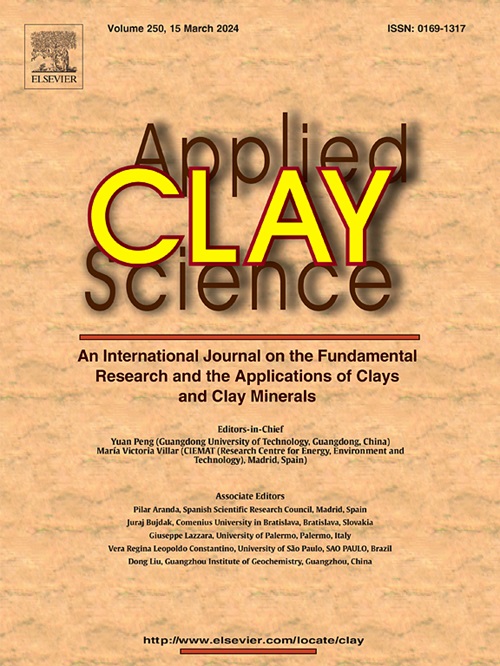Montmorillonite enhances the remediation of lead (II) by polyvinyl alcohol/sodium alginate/Chlorella sorokiniana FK microcapsules
IF 5.3
2区 地球科学
Q2 CHEMISTRY, PHYSICAL
引用次数: 0
Abstract
Microbial remediation of heavy metals has attracted more and more attention because of its cleanliness and high efficiency. In this study, montmorillonite was used in coordination with polyvinyl alcohol and sodium alginate to prepare a new microcapsule of living Chlorella sorokiniana FK, and its remediation effect on Pb(II) was investigated. The results showed that the introduction of montmorillonite enhanced the mechanical strength of microcapsules and the removal efficiency of Pb(II) (100 %). The staining results of live/dead cells further indicated that the introduction of montmorillonite can more effectively help Chlorella sorokiniana FK in microcapsules resist lead stress. In addition, the characterization results proved that microcapsules can concentrate Pb(II) on the surface through electrostatic attraction, surface complexation, and ion exchange, and then transform them into mineralized precipitates (Pb5(PO4)3Cl and Pb3(CO3)2(OH)2) through the surface precipitation and induced carbonate precipitation of internal microalgae. It is worth noting that pot experiments have shown that the prepared microcapsules can more effectively reduce the bioavailability of lead and improve the structure and function of microbial communities. This study indicates that the prepared microcapsules have great potential for application in heavy metals remediation.

蒙脱土增强聚乙烯醇/海藻酸钠/小球藻FK微胶囊对铅(II)的修复作用
微生物修复重金属因其清洁、高效等优点越来越受到人们的重视。本研究采用蒙脱土与聚乙烯醇、海藻酸钠配合制备了一种新型的小球藻活性微胶囊,并对其对铅(II)的修复效果进行了研究。结果表明,蒙脱土的引入提高了微胶囊的机械强度和Pb(II)的去除效率(100%)。活/死细胞染色结果进一步表明,蒙脱土的引入能更有效地帮助小球藻抗铅胁迫。此外,表征结果证明微胶囊可以通过静电吸引、表面络合和离子交换将Pb(II)富集在表面,然后通过微藻内部的表面沉淀和诱导碳酸盐沉淀将其转化为矿化沉淀(Pb5(PO4)3Cl和Pb3(CO3)2(OH)2)。值得注意的是,盆栽实验表明,制备的微胶囊可以更有效地降低铅的生物利用度,改善微生物群落的结构和功能。该研究表明,所制备的微胶囊在重金属修复中具有很大的应用潜力。
本文章由计算机程序翻译,如有差异,请以英文原文为准。
求助全文
约1分钟内获得全文
求助全文
来源期刊

Applied Clay Science
地学-矿物学
CiteScore
10.30
自引率
10.70%
发文量
289
审稿时长
39 days
期刊介绍:
Applied Clay Science aims to be an international journal attracting high quality scientific papers on clays and clay minerals, including research papers, reviews, and technical notes. The journal covers typical subjects of Fundamental and Applied Clay Science such as:
• Synthesis and purification
• Structural, crystallographic and mineralogical properties of clays and clay minerals
• Thermal properties of clays and clay minerals
• Physico-chemical properties including i) surface and interface properties; ii) thermodynamic properties; iii) mechanical properties
• Interaction with water, with polar and apolar molecules
• Colloidal properties and rheology
• Adsorption, Intercalation, Ionic exchange
• Genesis and deposits of clay minerals
• Geology and geochemistry of clays
• Modification of clays and clay minerals properties by thermal and physical treatments
• Modification by chemical treatments with organic and inorganic molecules(organoclays, pillared clays)
• Modification by biological microorganisms. etc...
 求助内容:
求助内容: 应助结果提醒方式:
应助结果提醒方式:


